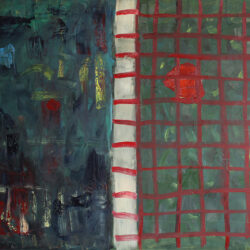In the process of analysis, Nemes was inspired by many artists, works and ways of thinking. Currently, for example, the creators of the trends marked “provisional painting” and “new casual”. But the impact that has been present since the beginning of his career belongs to Jasper Johns. He transferred the abstract textile pattern from Edward Munch’s self-portrait ‘Between the Clock and the Bed’ into his own works, transforming the surface of the painting into an endless pattern, defining a whole series with this theme.
Furthermore, the influence of the French group Supports / Surfaces, which was formed in the early 1960s and was active until 1971 was also important. In their work painting (in the spirit of Althusser) appeared as means of cognition and an object of experience, and touched mainly on the question of how painting could remain a politically valid critical practice. And also how the process of creation and artistic activity can be free. Supports / Surfaces deconstructed the painting as a “real object”, breaking it down into basic elements – base (blind frame), surface (canvas), color / paint – as a separate work. The rhythm and playfulness of the repeating abstract forms, line networks, the surfaces that create a feeling of infinity and radical reduction define their work.
In Csaba Nemes’s recent works, this kind of attitude, forms and experimental spirit appear in such a way that he remains a consistent, conscious continuator of his previous activity in several aspects. Like in the series Grayscale, figuratively painted social issues and abstract compositions also appear. The use of color earlier in the Father’s Name series, referring to documentation and black-and-white photography, is now a radical gesture of giving up the broad spectrum of color. The absence of color raises the question of what painting really is.
Range, the title of another of his new series, uses intense colors. Also, by the term Range, it asks the expression of the objective dimensions of the painting. It is about the strategy of creation and the intellectual dynamics of inclusion. The different meaning layers of the English word: attraction, field of interest, space, extent, direction, scale, choice, series refer not only to artistic processes in general, but also to changes in the Nemes’s attitude and practice.
The non-figurative images formed from the structures of lines, signs, planes and impulsive brush strokes (on the one hand the infinite surface and space, and on the other hand the playfulness, rhythm and dynamics of the sensual, joyful process of painting can be experienced directly) make the mediating role of linguistic, narrative structures unnecessary. Implementing “Emancipatory and Democratic Abstraction” (concept by Barnabás Zemlényi-Kovács) for both the artist and the viewer of the work, thus outlining a new horizon in painting.
Erzsébet Pilinger
